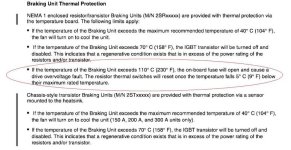I think we need to review the ratings here and it is important to do it in the right sequence.
First, the drive itself has a motoring and a braking horsepower rating. Usually, they are the same. Both are enforced by the current limit trip. So, if you have a 20hp drive and need 30hp of braking, it won't happen.
Assuming the drive is sized properly, the specific model of drive is spec'ed for a particular brake chopper size. This brake chopper will have a specific current limit. Or, rather than a current limit, the chopper may be rated for a particular minimum resistance. It is important to not go under this minimum resistance or you can damage the chopper.
Now, given the minimum brake resistance (which will give you the maximum braking capacity), you need to figure the resistor wattage. If you are slam-stopping a relatively light machine, the brake resistor runs cold and occasionally gets hit with braking energy for a few seconds. Under these conditions, the resistor wattage can be as little as 10% of the actual braking wattage. Unfortunately, stopping a heavy centrifuge is not that kind of situation.
The longer the braking continues, the closer to actual wattage the resistors need to be sized. If the stop is expected to take 120 seconds, you might as well figure full wattage as that is approaching nearly continuous duty. 20hp of braking is 20 x .746kw = 14.92kw so you will need at least 15kw of resistors to keep the heat under control while braking.
So, start with the drive size, find the proper chopper size, find the minimum resistance allowable, and then figure the wattage. That's what you should have. Less than that equals overheated resistors, blown choppers or, if you are lucky, only blown chopper fuses.
Let us know where you end up on this.





